Yi people
The Yi or Nuosuo people (historically known as Lolo),[note 1] are an ethnic group in China, Vietnam and Thailand. Numbering nine million people, they are the seventh largest of the 55 ethnic minority groups officially recognized by the People's Republic of China. They live primarily in rural areas of Sichuan, Yunnan, Guizhou and Guangxi, usually in mountainous regions. Liangshan Yi Autonomous Prefecture is home to the largest population of Yi people within mainland China, with two million Yi people in the region. For other countries, as of 1999, there were 3,300 Mantsi-speaking "Lô Lô" people living in the Hà Giang, Cao Bằng and Lào Cai provinces in Northern Vietnam.
ယီလူမျိုး ꆈꌠ 彝族 Alternative names: Nuosu and dozens of others | |
|---|---|
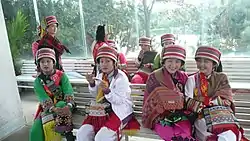 | |
| Total population | |
| 9 million (2010) | |
| Regions with significant populations | |
| China (Yunnan, Sichuan, Guizhou, Guangxi): 9 million (2010) Vietnam: 4,827 (2019)[1] Thailand and Laos: 2,203 (2015) | |
| Languages | |
| Yi (majority); Southwestern Mandarin (minority) | |
| Religion | |
| Majority - Bimoism (native Yi variety of Shamanism); minority - Taoism, Tibetan Buddhism | |
| Related ethnic groups | |
| Bamar, Naxi, Qiang, Tibetan, Tujia |
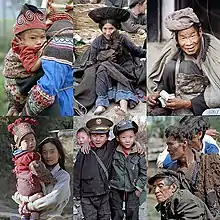
The Yi speak various Loloish languages, closely related to Burmese. The prestige variety is Nuosu, which is written in the Yi script.
Location
Of the more than 9 million Yi people, over 4.5 million live in Yunnan Province, 2.5 million live in southern Sichuan Province and 1 million live in the northwest corner of Guizhou Province. Nearly all the Yi live in mountainous areas, often carving out their existence on the sides of steep mountain slopes far from the cities of China.
The altitudinal differences of the Yi areas directly affect the climate and precipitation of these areas. These striking differences are the basis of the old saying that "The weather is different a few miles away" in the Yi area. Yi populations in different areas are very different from one another, making their living in completely different ways.[2]
Subgroups
Although different groups of Yi refer to themselves in different ways (including Nisu, Sani, Axi, Lolo, Acheh) and sometimes speak mutually unintelligible languages, they have been grouped into a single ethnicity by the Chinese and the various local appellations can be classified into three groups:
- Ni (ꆀ). The appellations of Nuosu,[3] Nasu, Nesu, Nisu and other similar names are considered derivatives of the original autonym “ꆀ” (Nip) appended with the suffix -su, indicating "people". The name "Sani" is also a variety of this group. Further, it is widely believed that the Chinese names 夷 and 彝 (both pinyin: Yí) were derived from Ni.
- Lolo. The appellations of Lolo, Lolopu, etc. are related to the Yi people's worship of the tiger, as “lo” in their dialects means "tiger". "Lo" is also the basis for the Chinese exonym Luóluó 猓猓, 倮倮 or 罗罗. The original character 猓, with the "dog radical" 犭and a guǒ 果 phonetic, was a graphic pejorative,[4] comparable to the Chinese name guǒran 猓然, "a long-tailed ape". Languages reforms in the PRC replaced the 猓 character in Luóluó twice. First by Luó 倮, with the "human radical" 亻and the same phonetic, but that was a graphic variant for luǒ 裸, "naked" and later by Luó 罗, "net for catching birds". Paul K. Benedict noted, "a leading Chinese linguist, has remarked that the name 'Lolo' is offensive only when written with the 'dog' radical.[5]
- Other. This group includes various other appellations of different groups of Yi. Some of them may be of other ethnic groups but are recognised as Yi by the Chinese. The "Pu" may be relevant to an ancient ethnic group Pu (濮). In the legends of the Northern Yi, the Yi people conquered Pu and its territory in the northeastern part of the modern Liangshan.
(Groups listed below are sorted by their broad linguistic classification and the general geographic area where they live. Within each section, larger groups are listed first.)
| Classification | Approximate total population | Groups |
|---|---|---|
| Southern | 1,082,120 | Nisu, Southern Nasu, Muji, A Che, Southern Gaisu, Pula, Boka, Lesu, Chesu, Laowu, Alu, Azong, Xiuba |
| Southeastern | 729,760 | Poluo, Sani, Axi, Azhe, Southeastern Lolo, Jiasou, Puwa, Aluo, Awu, Digao, Meng, Xiqi, Ati, Daizhan, Asahei, Laba, Zuoke, Ani, Minglang, Long |
| Central | 565,080 | Lolopo, Dayao Lipo, Central Niesu, Enipu, Lopi, Popei |
| Eastern | 1,456,270 | Eastern Nasu, Panxian Nasu, Wusa Nasu, Shuixi Nosu, Wuding Lipo, Mangbu Nosu, Eastern Gepo, Naisu, Wumeng, Naluo, Samei, Sanie, Luowu, Guopu, Gese, Xiaohei Neisu, Dahei Neisu, Depo, Laka, Lagou, Aling, Tushu, Gouzou, Wopu, Eastern Samadu |
| Western | 1,162,040 | Mishaba Laluo, Western Lolo, Xiangtang, Xinping Lalu, Yangliu Lalu, Tusu, Gaiji, Jiantou Laluo, Xijima, Limi, Mili, Lawu, Qiangyi, Western Samadu, Western Gepo, Xuzhang Lalu, Eka, Western Gaisu, Suan, Pengzi |
| Northern | 2,534,120 | Shengba Nosu, Yinuo Nosu, Xiaoliangshan Nosu, Butuo Nosu, Suodi, Tianba Nosu, Bai Yi, Naruo, Naru, Talu, Mixisu, Liwu, Northern Awu, Tagu, Liude, Naza, Ta'er |
| Unclassified | 55,490 | Michi (Miqie), Jinghong Nasu, Apu, Muzi, Tanglang, Micha, Ayizi, Guaigun |
History

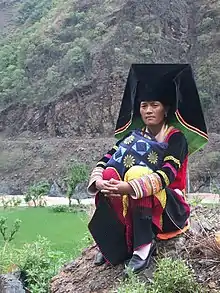
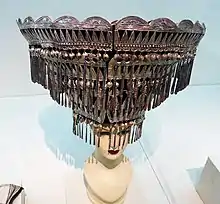
According to Yi legend, all life originated in water and water was created by snowmelt, which as it dripped down, created a creature called the Ni. The Ni gave birth to all life. Ni is another name for the Yi people. It is sometimes translated as black because black is a revered color in Yi culture.[6] Yi tradition tells us that their common ancestor was named Apu Dumu ꀉꁌꅋꃅ or ꀉꁌꐧꃅ (Axpu Ddutmu or Axpu Jjutmu). Apu Dumu had three wives, each of whom had two sons. The six sons migrated to the area that is now Zhaotong and spread out in the four directions, creating the Wu, Zha, Nuo, Heng, Bu, and Mo clans.[7] The Yi practiced a lineage system where younger brothers were treated as slaves by their elders, which resulted in a culture of migration where younger brothers constantly left their villages to create their own domains.[6]
Guizhou kingdoms
The Heng clan divided into two branches. One branch, known as the Wumeng settled along the western slope of the Wumeng Mountain range, extending their control as far west as modern day Zhaotong. The other branch, known as the Chele, moved along the eastern slope of the Wumeng Mountain range and settled to the north of the Chishui River. By the Tang dynasty (618-907), the Chele occupied the area from Xuyong in Sichuan to Bijie in Guizhou. The Bu clan fragmented into four branches. The Bole branch settled in Anshun, the Wusa branch settled in Weining, the Azouchi branch settled in Zhanyi, and the Gukuge branch settled in northeast Yunnan. The Mo clan, descended from Mujiji (慕齊齊), split into three branches. One branch known as the Awangren, led by Wualou, settled in southwest Guizhou and formed the Ziqi Kingdom. Wuake led the second branch, the Ayuxi, to settle near Ma'an Mountain south of Huize. Wuana led the third branch to settle in Hezhang. In the 3rd century AD, Wuana's branch split into the Mangbu branch in Zhenxiong, led by Tuomangbu, and Luodian (羅甸) in Luogen, led by Tuoazhe. By 300, Luodian covered over much of the Shuixi region. Its ruler, Mowang (莫翁), moved the capital to Mugebaizhage (modern Dafang), where he renamed his realm the Mu'ege kingdom, otherwise known as the Chiefdom of Shuixi.[7]
| Kingdom | Ruling clan | Modern area |
|---|---|---|
| Badedian | Mangbu | Zhenxiong |
| Luodian/Luoshi | Bole | Anshun |
| Mu'ege | Luo | Dafang |
| Ziqi/Yushi | Awangren | Southwest Guizhou |
After the Han dynasty, the Shu of the Three Kingdoms conducted several wars against the ancestors of Yi under the lead of Zhuge Liang. They defeated the king of Yi, ꂽꉼ (Mot Hop, 孟获) and expanded their conquered territory in Yi area. After that, the Jin Dynasty succeed Shu as the suzerainty of Yi area but with weak control.
Yunnan kingdoms
Some historians believe that the majority of the kingdom of Nanzhao were of the Bai people,[8] but that the elite spoke a variant of Nuosu (also called Yi), a Tibeto-Burman language closely related to Burmese.[9] The Cuanman people came to power in Yunnan during Zhuge Liang's Southern Campaign in 225. By the fourth century they had gained control of the region, but they rebelled against the Sui dynasty in 593 and were destroyed by a retaliatory expedition in 602. The Cuan split into two groups known as the Black and White Mywa.[10] The White Mywa (Baiman) tribes, who are considered the predecessors of the Bai people, settled on the fertile land of western Yunnan around the alpine fault lake Erhai. The Black Mywa (Wuman), considered to be predecessors of the Yi people, settled in the mountainous regions of eastern Yunnan. These tribes were called Mengshe (蒙舍), Mengxi (蒙嶲), Langqiong (浪穹), Tengtan (邆賧), Shilang (施浪), and Yuexi (越析). Each tribe was known as a zhao.[11] In academia, the ethnic composition of the Nanzhao kingdom's population has been debated for a century. Chinese scholars tend to favour the theory that the rulers came from the aforementioned Bai or Yi groups, while some non-Chinese scholars subscribed to the theory that the Tai ethnic group was a major component, that later moved south into modern-day Thailand and Laos.[12]
In 649, the chieftain of the Mengshe tribe, Xinuluo (細奴邏), founded the Great Meng (大蒙) and took the title of Qijia Wang (奇嘉王; "Outstanding King"). He acknowledged Tang suzerainty.[13] In 652, Xinuluo absorbed the White Mywa realm of Zhang Lejinqiu, who ruled Erhai Lake and Cang Mountain. This event occurred peacefully as Zhang made way for Xinuluo of his own accord. The agreement was consecrated under an iron pillar in Dali. Thereafter the Black and White Mywa acted as warriors and ministers respectively.[11]
In 704 the Tibetan Empire made the White Mywa tribes into vassals or tributaries.[10]
In the year 737 AD, with the support of the Tang dynasty, the great grandson of Xinuluo, Piluoge (皮羅閣), united the six zhaos in succession, establishing a new kingdom called Nanzhao (Mandarin, "Southern Zhao"). The capital was established in 738 at Taihe, (the site of modern-day Taihe village, a few miles south of Dali). Located in the heart of the Erhai valley, the site was ideal: it could be easily defended against attack and it was in the midst of rich farmland.[14] Under the reign of Piluoge, the White Mywa were removed from eastern Yunnan and resettled in the west. The Black and White Mywa were separated to create a more solidified caste system of ministers and warriors.[11]
Nanzhao existed for 165 years until A.D. 902. After 35 years of tangled warfare, Duan Siping (段思平) of the Bai birth founded the Kingdom of Dali, succeeding the territory of Nanzhao. Most Yi of that time were under the ruling of Dali. Dali's sovereign reign lasted for 316 years until it was conquered by Kublai Khan. During the era of Dali, Yi people lived in the territory of Dali but had little communication with the royalty of Dali.
Kublai Khan included Dali in his domain, grouping it with Tibet. The Yuan emperors remained firmly in control of the Yi people and the area they inhabited as part of Kublai Khan's Yunnan Xingsheng (云南行省) at current Yunnan, Guizhou and part of Sichuan. In order to enhance its sovereign over the area, the Yuan dynasty set up a dominion for Yi, Luoluo Xuanweisi (罗罗宣慰司), the name of which means local appeasement government for Lolos. Although technically under the rule of the Yuan emperor, the Yi still had autonomy during the Yuan dynasty. The gulf between aristocrats and the common people increased during this time.
Ming and Qing dynasties
Beginning with the Ming dynasty, the Chinese empire expedited its cultural assimilation policy in Southwestern China, spreading the policy of gaitu guiliu (改土归流; 'replacing tusi') [local chieftains] with ′normal′ officials").[15] The governing power of many Yi feudal lords had previously been expropriated by the successors of officials assigned by the central government. With the progress of gaitu guiliu, the Yi area was dismembered into many communities both large and small, and it was difficult for the communities to communicate with each other as there were often Han-ruled areas between them.
The Kangxi Emperor of the Qing dynasty defeated Wu Sangui and took over the land of Yunnan and established a provincial government there. When Ortai became the Viceroy of Yunnan and Guizhou during the era of Yongzheng Emperor, the policy of gaitu guiliu and cultural assimilation against Yi were strengthened. Under these policies, Yi who lived near Kunming were forced to abandon their convention of traditional cremation and adopt burial, a policy which triggered rebellions among the Yi. The Qing dynasty suppressed these rebellions.
After the Second Opium War (1856–1860), many Christian missionaries from France and Great Britain visited the area in which the Yi lived. Although some missionaries believed that Yi of some areas such as Liangshan were not under the ruling of Qing dynasty and should be independent, most aristocrats insisted that Yi was a part of China despite their resentment against Qing rule.
Modern era
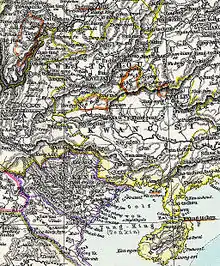
Long Yun, a Yi, was the military governor of Yunnan, during the Republic of China rule on mainland China.
The Fourth Front Army of the CCP encountered the Yi people during the Long March and many Yi joined the communist forces.[16]
After the establishment of the PRC, several Yi autonomous administrative districts of prefecture or county level were set up in Sichuan, Yunnan and Guizhou. With the development of automotive traffic and telecommunications, the communications among different Yi areas have been increasing sharply.
Yi polities throughout history
- Cuanmans
- Mu'ege Kingdom (circa 300–1279), afterwards known as the Chiefdom of Shuixi from 1279 to 1698
- Nanzhao Empire (738–937)
- Luodian Kingdom (羅甸國) of the Bole clan in present-day Luodian County, Yunnan
- Badedian Kingdom of the Mangbu Azhe clan in present day Zhenxiong[17]
- Luogui Kingdom (羅鬼國) (10th century–1278) in Guizhou
- Ziqi Kingdom (Yushi) (自杞國) (1100–1260) of the Awangren clan in present-day Xingyi, Guizhou
- Kingdom of Shu (1621–1629), a short-lived state during the She-An Rebellion
Language

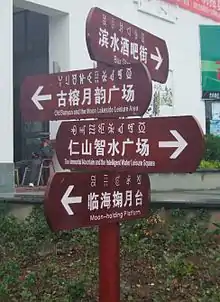
The Chinese government recognizes six mutually unintelligible Yi languages, from various branches of the Loloish family:[18]
- Northern Yi (Nuosu 诺苏)
- Western Yi (Lalo 腊罗)
- Central Yi (Lolopo 倮倮泼)
- Southern Yi (Nisu 尼苏)
- Southeastern Yi (Sani 撒尼)
- Eastern Yi (Nasu 纳苏)
Northern Yi is the largest with some two million speakers and is the basis of the literary language. It is an analytic language.[19] There are also ethnically Yi languages of Vietnam which use the Yi script, such as Mantsi.
Many Yi in Yunnan, Guizhou and Guangxi know Standard Chinese and code-switching between Yi and Chinese is common.
Script
The Yi script was originally logosyllabic like Chinese and dates to at least the 13th century. There were perhaps 10,000 characters, many of which were regional, since the script had never been standardized across the Yi peoples. A number of works of history, literature and medicine, as well as genealogies of the ruling families, written in the Old Yi script are still in use and there are Old Yi stone tablets and steles in the area.
Under the Communist government, the script was standardized as a syllabary. Syllabic Yi is widely used in books, newspapers and street signs.
Culture

Slavery
Traditional Yi society was divided into four castes, the aristocratic nuohuo Black Yi, the commoner qunuo White Yi, the ajia, and the xiaxi. The Black Yi made up around 7 per cent of the population while the White Yi made up 50 per cent of the population. The two castes did not intermarry and the Black Yi were always considered of higher status than the White Yi, even if the White Yi was wealthier or owned more slaves. The White and Black Yi also lived in separate villages. The Black Yi did not farm, which was traditionally done by White Yi and slaves. Black Yi were responsible only for administration and military activities. The White Yi were not technically slaves but lived as indentured servants to the Black Yi. The Ajia made up 33 per cent of the population. They were owned by both the Black and White Yi and worked as indentured laborers lower than the White Yi. The Xiaxi were the lowest caste. They were slaves who lived with their owners' livestock and had no rights. They could be beaten, sold, and killed for sport. Membership of all four castes was through patrilineal descent.[20][21][22][23][24][25] The prevalence of the slave culture was so great that sometimes children were named after how many slaves they owned. For example: Lurbbu (many slaves), Lurda (strong slaves), Lurshy (commander of slaves), Lurnji (origin of slaves), Lurpo (slave lord), Lurha, (hundred slaves), Jjinu (lots of slaves).[26]
Folklore
The most famous hero in Yi mythology is Zhyge Alu. He was the son of a dragon and an eagle who possessed supernatural strength, anti-magic, and anti-ghost powers. He rode a nine-winged flying horse called "long heavenly wings." He also had the help of a magical peacock and python. The magical peacock was called Shuotnie Voplie and could deafen the ears of those who heard its cry, but if invited into one's house, would consume evil and expel leprosy. The python, called Bbahxa Ayuosse, was defeated by Zhyge Alu, who wrestled with it in the ocean after transforming into a dragon. It was said to be able to detect leprosy, cure tuberculosis, and eradicate epidemics. Like the Chinese mythological archer, Hou Yi, Zhyge Alu shoots down the suns to save the people. In the Yi religion Bimoism, Zhyge Alu aids the bimo priests in curing leprosy and fighting ghosts.[27]
Jiegujienuo was a ghost that caused dizziness, slowness in action, dementia and anxiety. The ghost was blamed for ailments and exorcism rituals were conducted to combat the ghost. The bimo erected small sticks considered to be sacred, the kiemobbur, at the ritual site in preparation.[27]
Torch Festival
The Torch Festival is one of the Yi people's main holidays. According to Yi legend, there were once two men of great strength, Sireabi and Atilaba. Sireabi lived in heaven while Atilaba on earth. When Sireabi heard of Atilaba's strength, he challenged Atilaba to a wrestling match. After suffering two defeats, Sireabi was killed in a bout, which greatly angered the bodhisattavas, who sent a plague of locusts to punish the earth. On the 24th day of the 6th month of the lunar calendar, Atilaba cut down many pine trees and used them as torches to kill the locusts, protecting the crops from destruction. The Torch Festival is thus held in his honor.[28]
Music
The Yi play a number of traditional musical instruments, including large plucked and bowed string instruments,[29] as well as wind instruments called bawu (巴乌) and mabu (马布). The Yi also play the hulu sheng, though unlike other minority groups in Yunnan, the Yi do not play the hulu sheng for courtship or love songs (aiqing). The kouxian, a small four-pronged instrument similar to the Jew's harp, is another commonly found instrument among the Liangshan Yi. Kouxian songs are most often improvised and are supposed to reflect the mood of the player or the surrounding environment. Kouxian songs can also occasionally function in the aiqing form. Yi dance is perhaps the most commonly recognized form of musical performance, as it is often performed during publicly sponsored holidays and/or festival events.
Literature
Artist Colette Fu, great granddaughter of Long Yun has spent time from 1996 till present photographing the Yi community in Yunnan Province. Her series of pop-up books, titled We are Tiger Dragon People, includes images of many Yi groups.[30][31]
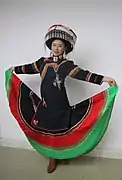 Yi woman in traditional dress
Yi woman in traditional dress Yi woman in traditional dress with a child
Yi woman in traditional dress with a child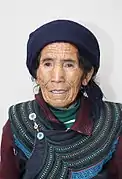 Yi woman in traditional dress
Yi woman in traditional dress Yi man in traditional dress
Yi man in traditional dress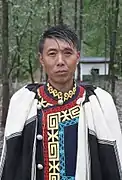 Yi man in traditional dress
Yi man in traditional dress
Religion

Bimoism
Bimoism is the ethnic religion of the Yi. Shaman-priests of this faith are known as bimo, which means 'master of scriptures'. Bimo officiate at births, funerals, weddings and holidays. The Nuosu form of Bimoism distinguishes two sorts of shamans: the bimo and the suni, respectively hereditary and ordained priests. A bimo can only be inherited through patrilineal descent, similar to the broader Yi society, after a time of apprenticeship or formally acknowledging an old bimo as the teacher. A suni is elected. Bimo are the most revered, to the point that the Nuosu religion is called "bimo religion". Bimo can read Yi scripts while suni cannot. Both can perform rituals, but only bimo can perform rituals linked to death. For most cases, suni only perform some exorcism to cure diseases. Generally, suni can only be from humble civil birth while bimo can be of both aristocratic and humble families.[32]
The Yi worship deified ancestors, similar to Chinese folk religion, but also gods of nature: fire, hills, trees, rocks, water, earth, sky, wind and forests.
Ritual performances play a major role in daily life through healing, exorcism, asking for rain, cursing enemies, blessing, divination and analysis of one's relationship with the gods. They believe dragons protect villages against bad spirits, and demons cause diseases. After someone dies they sacrifice a pig or sheep at the doorway to maintain relationship with the deceased spirit. The Yi believe that bad spirits cause illness, poor harvests and other misfortunes and inhabit all material things. The Yi also believe in multiple souls. At death, one soul remains to watch the grave while the other is eventually reincarnated into some living form.
In recent decades the Bimoist faith has undergone a revival, with large temples built in the early-2010s.[33][34][35]
Other religions
In Yunnan, some of the Yi have adopted Buddhism as a result of exchanges with other predominantly Buddhist ethnic groups present in Yunnan, such as the Dai and the Tibetans. The most important god of Yi Buddhism is Mahākāla, a wrathful deity found in Vajrayana and Tibetan Buddhism. In the 20th century, some Yi people in China converted to Christianity, after the arrival of Gladstone Porteous in 1904 and, later, medical missionaries such as Alfred James Broomhall, Janet Broomhall, Ruth Dix and Joan Wales of the China Inland Mission. According to missionary organization OMF International, the exact number of Yi Christians is not known. In 1991 it was reported that there were as many as 1,500,000 Yi Christians in Yunnan Province, especially in Luquan County where there are more than 20 churches.[36]
Medicine
The Yi are known for the extent of their inter-generational transmission of traditional medicine through oral tradition and written records. Their traditional medicine system has been academically inventoried.[37] Since the prefecture the Yi medicinal data was collected from also contains the cave containing human-infectable SARS clades and it is known that people living in the vicinity SARS caves show serological signs of past infection,[38][39] it has been suggested that the Yi were repeatably exposed to coronavirus over their history, passively learned to medicinally fend off coronavirus infection centuries ago, and committed the results into their inter-generational record of medicinal indications.[40]
Distribution
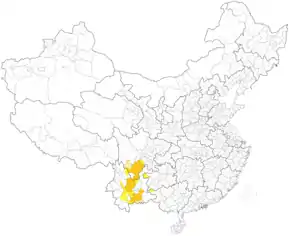
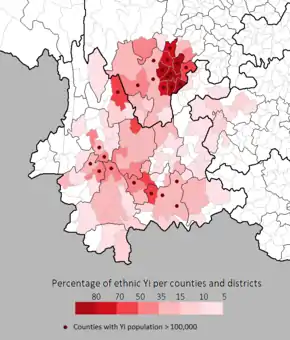
- County-level distribution of the Yi 2000 census in China.
(Only includes counties or county-equivalents containing >1% of county population.)
| County/city | Yi % | Yi population | Total population |
|---|---|---|---|
| Sichuan province | 2.58 | 2,122,389 | 82,348,296 |
| Panzhihua city | 10.11 | 110,326 | 1,091,657 |
| Dong district | 1.25 | 3,945 | 315,707 |
| Xi district | 1.84 | 3,148 | 170,862 |
| Renhe district | 19.06 | 38,907 | 204,170 |
| Miyi county | 13.21 | 27,381 | 207,300 |
| Yanbian county | 19.08 | 36,945 | 193,618 |
| Leshan city | 3.53 | 117,355 | 3,324,139 |
| Jinkouhe district | 10.15 | 5,373 | 52,916 |
| Ebian Yi autonomous county | 30.65 | 43,269 | 141,166 |
| Mabian Yi autonomous county | 39.15 | 66,723 | 170,425 |
| Pingshan county | 2.00 | 5,004 | 250,620 |
| Yaan city | 2.04 | 31,013 | 1,522,845 |
| Hanyuan county | 4.51 | 15,686 | 347,471 |
| Shimian county | 11.17 | 13,769 | 123,261 |
| Garze Tibetan autonomous prefecture | 2.56 | 22,946 | 897,239 |
| Luding county | 4.40 | 3,424 | 77,855 |
| Jiulong county | 37.01 | 18,806 | 50,816 |
| Liangshan Yi autonomous prefecture | 44.43 | 1,813,683 | 4,081,697 |
| Xichang city | 16.48 | 101,369 | 615,212 |
| Muli Tibetan autonomous county | 27.71 | 34,489 | 124,462 |
| Yanyuan county | 47.67 | 149,568 | 313,765 |
| Dechang county | 23.18 | 43,810 | 188,980 |
| Huili county | 17.33 | 75,064 | 433,185 |
| Huidong county | 6.91 | 24,279 | 351,310 |
| Ningnan county | 21.85 | 37,134 | 169,962 |
| Puge county | 76.55 | 106,521 | 139,156 |
| Butuo county | 95.44 | 132,285 | 138,604 |
| Jinyang county | 78.42 | 109,813 | 140,028 |
| Zhaojue county | 96.75 | 200,951 | 207,712 |
| Xide county | 85.74 | 118,048 | 137,676 |
| Mianning county | 33.39 | 108,289 | 324,332 |
| Yuexi county | 72.54 | 172,505 | 237,800 |
| Ganluo county | 68.66 | 120,445 | 175,426 |
| Meigu county | 97.81 | 172,356 | 176,214 |
| Leibo county | 51.36 | 106,757 | 207,873 |
| Guizhou province | 2.39 | 843,554 | 35,247,695 |
| Baiyun district | 1.04 | 1,961 | 187,695 |
| Qingzhen city | 1.65 | 7,761 | 471,305 |
| Liupanshui city | 9.56 | 262,308 | 2,744,085 |
| Zhongshan district | 5.64 | 25,549 | 453,293 |
| Liuzhi special district | 11.32 | 61,319 | 541,762 |
| Shuicheng county | 11.70 | 79,339 | 678,228 |
| Pan county | 8.97 | 96,101 | 1,070,802 |
| Qianxi'nan Bouyei Miao autonomous prefecture | 2.05 | 58,766 | 2,864,920 |
| Xingyi city | 2.02 | 14,521 | 719,605 |
| Xingren county | 2.44 | 10,372 | 425,091 |
| Puan county | 2.66 | 6,905 | 259,881 |
| Qinglong county | 6.76 | 17,436 | 258,031 |
| Anlong county | 2.28 | 9,094 | 399,384 |
| Bijie prefecture | 7.41 | 468,800 | 6,327,471 |
| Bijie city | 4.26 | 48,094 | 1,128,230 |
| Dafang county | 10.84 | 92,295 | 851,729 |
| Qianxi county | 8.67 | 60,420 | 697,075 |
| Jinsha county | 4.17 | 20,696 | 496,063 |
| Zhijin county | 3.81 | 31,420 | 825,350 |
| Nayong county | 5.72 | 37,840 | 661,772 |
| Weining Yi Hui Miao autonomous county | 9.06 | 95,629 | 1,056,009 |
| Hezhang county | 13.48 | 82,406 | 611,243 |
| Yunnan province | 11.11 | 4,705,658 | 42,360,089 |
| Kunming city | 6.65 | 384,531 | 5,781,294 |
| Wuhua district | 2.56 | 10,580 | 413,420 |
| Panlong district | 1.59 | 5,468 | 344,754 |
| Guandu district | 3.38 | 47,311 | 1,398,305 |
| Xishan district | 5.07 | 30,617 | 603,363 |
| Dongchuan district | 3.26 | 8,984 | 275,564 |
| Chenggong county | 1.22 | 2,202 | 180,685 |
| Jinning county | 7.64 | 20,443 | 267,739 |
| Fumin county | 7.44 | 10,422 | 140,046 |
| Yiliang county | 6.06 | 24,051 | 396,677 |
| Shilin Yi autonomous county | 32.49 | 72,779 | 223,978 |
| Luquan Yi Miao autonomous county | 22.45 | 96,388 | 429,355 |
| Xundian Hui Yi autonomous county | 8.91 | 42,934 | 481,721 |
| Anning city | 3.34 | 9,872 | 295,173 |
| Qujing city | 3.85 | 210,351 | 5,466,089 |
| Qilin district | 2.16 | 14,041 | 648,956 |
| Malong county | 3.41 | 6,326 | 185,766 |
| Shizong county | 6.21 | 21,718 | 349,770 |
| Luoping county | 6.44 | 33,159 | 515,211 |
| Fuyuan county | 7.16 | 47,076 | 657,474 |
| Huize county | 2.00 | 16,910 | 844,485 |
| Zhanyi county | 2.16 | 8,406 | 389,838 |
| Xuanwei city | 4.46 | 57,708 | 1,292,825 |
| Yuxi city | 19.32 | 400,412 | 2,073,005 |
| Hongta district | 9.02 | 36,905 | 409,044 |
| Jiangchuan county | 5.48 | 14,087 | 257,078 |
| Chengjiang county | 1.82 | 2,726 | 149,748 |
| Tonghai county | 5.82 | 16,017 | 275,063 |
| Huaning county | 21.29 | 41,844 | 196,519 |
| Yimen county | 26.75 | 45,362 | 169,581 |
| Eshan Yi autonomous county | 52.36 | 79,289 | 151,426 |
| Xinping Yi Dai autonomous county | 46.20 | 122,259 | 264,615 |
| Yuanjiang Hani Yi Dai autonomous county | 20.97 | 41,923 | 199,931 |
| Zhaotong prefecture | 3.23 | 148,521 | 4,592,388 |
| Zhaotong city | 2.58 | 18,758 | 727,959 |
| Ludian county | 2.51 | 8,686 | 345,740 |
| Qiaojia county | 2.86 | 13,183 | 461,034 |
| Daguan county | 1.98 | 4,667 | 235,802 |
| Yongshan county | 4.72 | 17,130 | 362,943 |
| Zhenxiong county | 5.78 | 63,463 | 1,097,093 |
| Yiliang county | 4.24 | 20,269 | 477,811 |
| Chuxiong Yi autonomous prefecture | 26.31 | 668,937 | 2,542,530 |
| Chuxiong city | 19.05 | 95,959 | 503,682 |
| Shuangbai county | 43.10 | 66,110 | 153,403 |
| Mouding county | 22.03 | 43,032 | 195,322 |
| Nanhua county | 36.07 | 82,223 | 227,970 |
| Yaoan county | 25.38 | 50,526 | 199,071 |
| Dayao county | 29.52 | 82,620 | 279,838 |
| Yongren county | 49.44 | 51,223 | 103,606 |
| Yuanmou county | 24.25 | 49,179 | 202,779 |
| Wuding county | 30.18 | 79,254 | 262,601 |
| Lufeng county | 16.61 | 68,811 | 414,258 |
| Honghe Hani Yi autonomous prefecture | 23.57 | 973,732 | 4,130,463 |
| Gejiu city | 20.27 | 91,902 | 453,311 |
| Kaiyuan city | 33.09 | 96,647 | 292,039 |
| Mengzi county | 29.38 | 99,917 | 340,051 |
| Pingbian Miao autonomous county | 18.51 | 27,596 | 149,088 |
| Jianshui county | 29.02 | 149,071 | 513,712 |
| Shiping county | 53.67 | 148,987 | 277,580 |
| Mile county | 30.92 | 153,235 | 495,642 |
| Luxi county | 7.99 | 29,202 | 365,585 |
| Yuanyang county | 24.01 | 87,137 | 362,950 |
| Honghe county | 14.23 | 38,086 | 267,627 |
| Jinping Miao Yao Dai autonomous county | 11.97 | 37,837 | 316,171 |
| Lüchun county | 4.92 | 9,894 | 201,256 |
| Hekou Yao autonomous county | 4.42 | 4,221 | 95,451 |
| Wenshan Zhuang Miao autonomous prefecture | 10.62 | 347,194 | 3,268,553 |
| Wenshan county | 17.28 | 74,255 | 429,639 |
| Yanshan county | 21.11 | 92,356 | 437,508 |
| Xichou county | 3.95 | 9,332 | 236,120 |
| Malipo county | 2.25 | 6,036 | 267,986 |
| Maguan county | 9.16 | 32,056 | 350,002 |
| Qiubei county | 18.05 | 78,327 | 434,009 |
| Guangnan county | 5.84 | 42,675 | 730,376 |
| Funing county | 3.17 | 12,157 | 382,913 |
| Pu'er city | 16.58 | 411,120 | 2,480,346 |
| Simao district | 15.12 | 34,904 | 230,834 |
| Ning'er Hani Yi autonomous county | 19.45 | 36,589 | 188,106 |
| Mojiang Hani autonomous county | 9.23 | 32,812 | 355,364 |
| Jingdong Yi autonomous county | 39.92 | 140,556 | 352,089 |
| Jinggu Dai Yi autonomous county | 20.59 | 59,476 | 288,794 |
| Zhenyuan Yi Hani Lahu autonomous county | 27.28 | 56,119 | 205,709 |
| Jiangcheng Hani Yi autonomous county | 13.47 | 13,503 | 100,243 |
| Menglian Dai Lahu Va autonomous county | 2.40 | 4,999 | 208,593 |
| Lancang Lahu autonomous county | 6.74 | 31,255 | 464,016 |
| Ximeng Va autonomous county | 1.05 | 907 | 86,598 |
| Xishuangbanna Dai autonomous prefecture | 5.61 | 55,772 | 993,397 |
| Jinghong city | 5.56 | 24,673 | 443,672 |
| Menghai county | 2.28 | 7,175 | 314,068 |
| Mengla county | 10.15 | 23,924 | 235,657 |
| Dali Bai autonomous prefecture | 12.94 | 426,634 | 3,296,552 |
| Dali city | 2.95 | 15,385 | 521,169 |
| Yangbi Yi autonomous county | 46.09 | 48,565 | 105,380 |
| Xiangyun county | 7.26 | 31,733 | 437,371 |
| Binchuan county | 6.27 | 20,332 | 324,412 |
| Midu county | 8.35 | 24,791 | 296,860 |
| Nanjian Yi autonomous county | 47.24 | 99,159 | 209,887 |
| Weishan Yi Hui autonomous county | 34.07 | 100,879 | 296,124 |
| Yongping county | 26.56 | 47,391 | 178,438 |
| Yunlong county | 5.45 | 10,739 | 196,978 |
| Eryuan county | 3.00 | 9,443 | 315,003 |
| Jianchuan county | 2.88 | 4,771 | 165,900 |
| Heqing county | 5.40 | 13,446 | 249,030 |
| Baoshan prefecture | 3.23 | 75,877 | 2,348,315 |
| Baoshan city | 4.61 | 39,025 | 846,865 |
| Shidian county | 3.62 | 11,360 | 314,187 |
| Longling county | 1.83 | 4,758 | 260,097 |
| Changning county | 6.04 | 20,123 | 333,241 |
| Lijiang prefecture | 18.68 | 210,431 | 1,126,646 |
| Lijiang Naxi autonomous county | 2.42 | 8,871 | 366,705 |
| Yongsheng county | 12.43 | 46,703 | 375,769 |
| Huaping county | 8.26 | 12,808 | 154,968 |
| Ninglang Yi autonomous county | 61.97 | 142,049 | 229,204 |
| Nujiang Lisu autonomous prefecture | 1.99 | 9,805 | 491,824 |
| Lushui county | 2.28 | 3,915 | 171,974 |
| Lanping Bai Pumi autonomous county | 2.91 | 5,727 | 196,977 |
| Diqing Tibetan autonomous prefecture | 3.29 | 11,616 | 353,518 |
| Zhongdian county | 6.50 | 9,586 | 147,416 |
| Weixi Lisu autonomous county | 1.38 | 2,016 | 146,017 |
| Lincang prefecture | 15.77 | 367,880 | 2,332,570 |
| Lincang county | 5.43 | 15,478 | 285,163 |
| Fengqing county | 27.61 | 117,883 | 426,943 |
| Yun county | 37.96 | 158,099 | 416,507 |
| Yongde county | 8.68 | 29,521 | 339,918 |
| Zhenkang county | 17.19 | 31,334 | 182,258 |
| Shuangjiang Lahu Va Blang Dai autonomous county | 1.57 | 2,605 | 165,982 |
| Gengma Dai Va autonomous county | 3.57 | 11,193 | 313,220 |
| Longlin autonomous county (Guangxi) | 1.03 | 3,563 | 347,462 |
Notable people
- Zhang Liyin (1989–), singer
- Jike Junyi (1988–), singer
- Long Yun (1884–1962), governor and warlord of Yunnan Province
- Lu Han (1895–1974), general and governor of Yunnan Province
Gallery
 Yi woman, Butuo County, Sichuan Province
Yi woman, Butuo County, Sichuan Province Huayao Yi women, Shiping County, Yunan Province
Huayao Yi women, Shiping County, Yunan Province A family tree document in Yi script
A family tree document in Yi script A Yi bracelet, Central Yunnan
A Yi bracelet, Central Yunnan Yi musical instrument: bamboo harmonica
Yi musical instrument: bamboo harmonica Yi musical instrument: three-strings
Yi musical instrument: three-strings_-_Yunnan_Provincial_Museum-_DSC02056.JPG.webp) Yi musical instrument: phambe
Yi musical instrument: phambe Fire Festival, Eshan County
Fire Festival, Eshan County_Province_(1910)_(14780854764).jpg.webp) Yi warrior, 1910
Yi warrior, 1910
See also
- Torch Festival
- Liangshan Yi Autonomous Prefecture
- Honghe Hani and Yi Autonomous Prefecture
- Chuxiong Yi Autonomous Prefecture
- Hani people
- Bai people
- Yiminaspis, a prehistoric fish named in honor of the Yi.
- The Art of Not Being Governed
Notes
References
Citations
- "Report on Results of the 2019 Census". General Statistics Office of Vietnam. Retrieved 1 May 2020.
- "Ethnic Groups - china.org.cn". China.org.cn. Retrieved 8 August 2014.
- Some scholars, however, argue that the Nuosu-series appellations are from the word "black" instead (ꆈ, Nuo).
- Ramsey, Robert S. (1987). The Languages of China, p. 160. Princeton University Press.
- Benedict, Paul K. (1987). "Autonyms: ought or ought not." Linguistics of the Tibeto-Burman Area 10: 188. Italics in original.
- https://publishing.cdlib.org/ucpressebooks/view?docId=kt896nd0h7&chunk.id=pt01&toc.depth=1&toc.id=pt01&brand=ucpress/
- Cosmo 2003, p. 248-249.
- Joe Cummings, Robert Storey (1991). China, Volume 10 (3, illustrated ed.). the University of California: Lonely Planet Publications. p. 705. ISBN 0-86442-123-0. Retrieved 15 May 2011.
- C. X. George Wei (2002). Exploring nationalisms of China: themes and conflicts. Indiana University: Greenwood Publishing Group. p. 195. ISBN 0-313-31512-4. Retrieved 15 May 2011.
- Beckwith 1987, p. 65.
- https://medium.com/@diantnam/the-faded-buddhist-country-a-brief-history-of-ancient-yunnan-constitution-f2bd5c9f52c7
- Zhou, Zhenhe; You, Rujie (8 September 2017). Chinese Dialects and Culture. American Academic Press. p. 187. ISBN 9781631818844.
- http://www.chinaknowledge.de/History/Altera/nanzhao.html
- Blackmore 1960.
- Ulrich Theobald, ChinaKnowledge.de: An Encyclopedia on Chinese History, Literature and Art, s.v. "gaitu guiliu", http://www.chinaknowledge.de/History/Terms/gaituguiliu.html
- Edgar, Snow. "Red Star Over China," 225. Harmondsworth, Middlesex, England: Penguin Books, 1972.
- Herman, John E. (2020). Amid the Clouds and Mist: China's Colonization of Guizhou, 1200–1700. Brill. p. 34. ISBN 978-1-68417-463-8.
- Andrew West, The Yi People and Language
- 向晓红; 曹幼南 (2006). "英语和彝语的语法比较研究". -西南民族大学学报(人文社科版). doi:10.3969/j.issn.1004-3926.2006.08.014.
- Martin Schoenhals Intimate Exclusion: Race and Caste Turned Inside Out 2003- Page 26 "A non-slave-owning Black Yi, or a poor one, was nonetheless always higher in caste status than any White Yi, even a wealthy one or one owning slaves, and the Black Yi manifested this superiority by refusing to marry White Yi even if the latter ..."
- Barbara A. West Encyclopedia of the Peoples of Asia and Oceania 2009 - Page 910 "Yi society prior to the revolution in 1949 was divided into four ranked classes or castes: Nuohuo, or Black Yi; Qunuo, or White Yi; Ajia; and Xiaxi. The Nuohuo, or Black Yi, was the highest and smallest caste at just about 7 percent of the ..."
- Yongming Zhou Anti-Drug Crusades in Twentieth-Century - China: Nationalism, ... - 1999 - Page 150 "The black Yi (about 7 percent of the population) made up the aristocratic ruling class, and the white Yi held subordinate status. Within the white Yi, however, there were three subgroups: Qunuo, Anjia, and Jiaxi. Qunuo (about 50 percent of the ...")
- S. Robert Ramsey The Languages of China 1987- Page 253 "The Black Yi looked down on farming, and all cultivation was traditionally done by White Yi and slaves. The Black Yi were responsible only for administration and military protection. Even so, however, they usually took great care to tend to their ..."
- Stevan Harrell Perspectives on the Yi of Southwest China 2001 - Page 174 "One village is for Black Yi, who speak Black Yi language. One village is for White Yi, who speak White Yi language. One place is for Red Yi, who speak Red Yi language. One village is for Gan Yi, who speak Gan Yi language. One village is for ..."
- Daniel H. Bays Christianity in China: From the Eighteenth Century to the Present 1999- Page 144 "In the local hierarchy of ethnic groups, they ranked near the bottom, below the Chinese, the Yi aristocracy (Black Yi) and free men (White Yi), and the Hui, closer to the Yi slave caste."
- https://publishing.cdlib.org/ucpressebooks/view?docId=kt896nd0h7&chunk.id=ch05&toc.depth=1&toc.id=ch05&brand=ucpress/
- https://www.burkemuseum.org/static/mountainpatterns/religion/spirit.html#zhyge
- South of the Clouds, 114-115
- "彝族人网-中国彝族文化网络博物馆,创建最早,规模最大的彝族文化门户网站-网站地图". yizuren.com. Retrieved 8 August 2014.
- Fu, Colette (2013). Yi costume festival. Colette Fu. OCLC 881525220.
- Fu, Colette; Wasserman, Krystyna (2016). Wanderer/Wonderer: Pop-Ups by Colette Fu : October 14, 2016-February 26, 2017. National Museum of Women in the Arts. OCLC 962923876.
- http://en.yizuren.com/Academic/33567.html
- 彝族六祖分支.
- 彝族分支圣地,神奇乌蒙昭通.
- 2012年中华彝族祭祖节祭祖大典在南诏土主庙举行.
- "OMF International". Retrieved 18 February 2008.
- Long et al. "Medicinal plants used by the Yi ethnic group: a case study in central Yunnan".
- Wang, N. et al. "Serological Evidence of Bat SARS-Related Coronavirus Infection in Humans, China"
- Li, HY et al. "Human-animal interactions and bat coronavirus spillover potential among rural residents in Southern China"
- Sheridan, R. "The forgotten legacy of Traditional Medicine in the age of coronavirus"
Sources
- Cheng Xiamin. A Survey of the Demographic Problems of the Yi Nationality in the Greater and Lesser Liang Mountains. Social Sciences in China. 3: Autumn 1984, 207–231.
- Clements, Ronald. Point Me to the Skies: the amazing story of Joan Wales. (Monarch Publications, 2007), ISBN 978-0-8254-6157-6.
- Dessaint, Alain Y. Minorities of Southwest China: An Introduction to the Yi (Lolo) and Related Peoples. (New Haven: HRAF Press, 1980).
- Du Ruofu and Vip, Vincent F. Ethnic Groups in China. (Beijing: Science Press, 1993).
- Goullart, Peter. Princes of the Black Bone. (John Murray, London, 1959).
- Grimes, Barbara F. Ethnologue. (Dallas: Wycliffe Bible Translators, 1988).
- Cultural Encounters on China's Ethnic Frontiers. The History of the History of the Yi. Edited by Stevan Harrell. (Seattle: University of Washington Press, 1995).
- Perspectives on the Yi of Southwest China. Edited by Stevan Harrell. (Berkeley / Los Angeles / London: University of California Press, 2001), ISBN 0-520-21988-0.
- China's Minority Nationalities. Edited by Ma Yin. (Beijing: Foreign Language Press, 1994).
- Zhang Weiwen and Zeng Qingnan. In Search of China's Minorities. (Beijing: New World Press).
- Ritual for Expelling Ghosts: A religious Classic of the Yi nationality in Liangshan Prefecture, Sichuan (The Taipei Ricci Institute, Nov. 1998), ISBN 957-9185-60-3.
Further reading
- Beckwith, Christopher I. (1987). The Tibetan Empire in Central Asia: A History of the Struggle for Great Power among Tibetans, Turks, Arabs, and Chinese during the Early Middle Ages. Princeton University Press.
- Benoît Vermander. L'enclos à moutons: un village nuosu du sud-ouest de la Chine. Paris: Les Indes savantes (2007).
- Blackmore, M. (1960). "The Rise of Nan-Chao in Yunnan". Journal of Southeast Asian History. 1 (2): 47–61. doi:10.1017/S0217781100000132.
- Cosmo, Nicola di (2003), Political Frontiers, Ethnic Boundaries, and Human Geographies in Chinese History
- Ollone, Henri d', vicomte (1912) In Forbidden China: the d'Ollone mission, 1906–1909, China--Tibet--Mongolia; translated from the French of the second edition by Bernard Miall. Chapters II-V & VII. London: T. Fisher Unwin.
- Pollard, S. (1921) In Unknown China: Record of the Observations, Adventures and Experiences of a Pioneer Missionary During a Prolonged Sojourn Amongst the Wild and Unknown Nosu Tribe of Western China London: Seeley Service and Co. Limited.
External links
| Wikimedia Commons has media related to Yi people. |
| Wikisource has the text of the 1911 Encyclopædia Britannica article Lolos. |
- China.org.cn. "The Yi ethnic minority".
- Yu-Hsiu Lu. "The Dishi septet Traditional music and dance Documentation."
- Peoples.org. "Yi Peoples of China".
- Yizuren.com. "Huge string instruments of the Yi".
- Vermander, B. "The Yis of Liangshan Prefecture".
- Vermander, B. "Nuosu Religion: Rituals, Agents and Belief".
- Ayi Bamo. "The Bi-mox in The Liangshan Yi Society."
- Perspectives on the Yi of Southwest China. Edited by Stevan Harrell.
- Map share of ethnic by county of China
